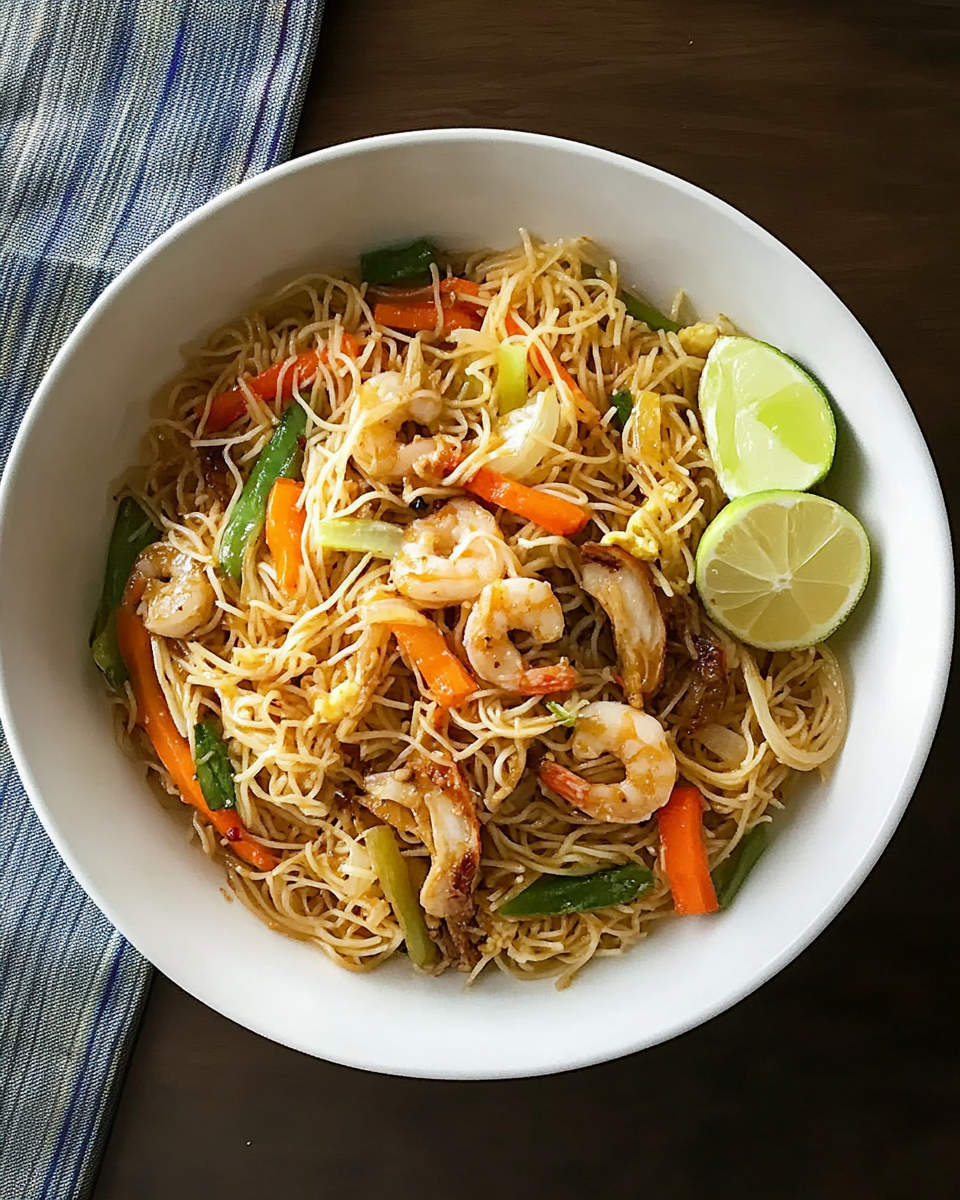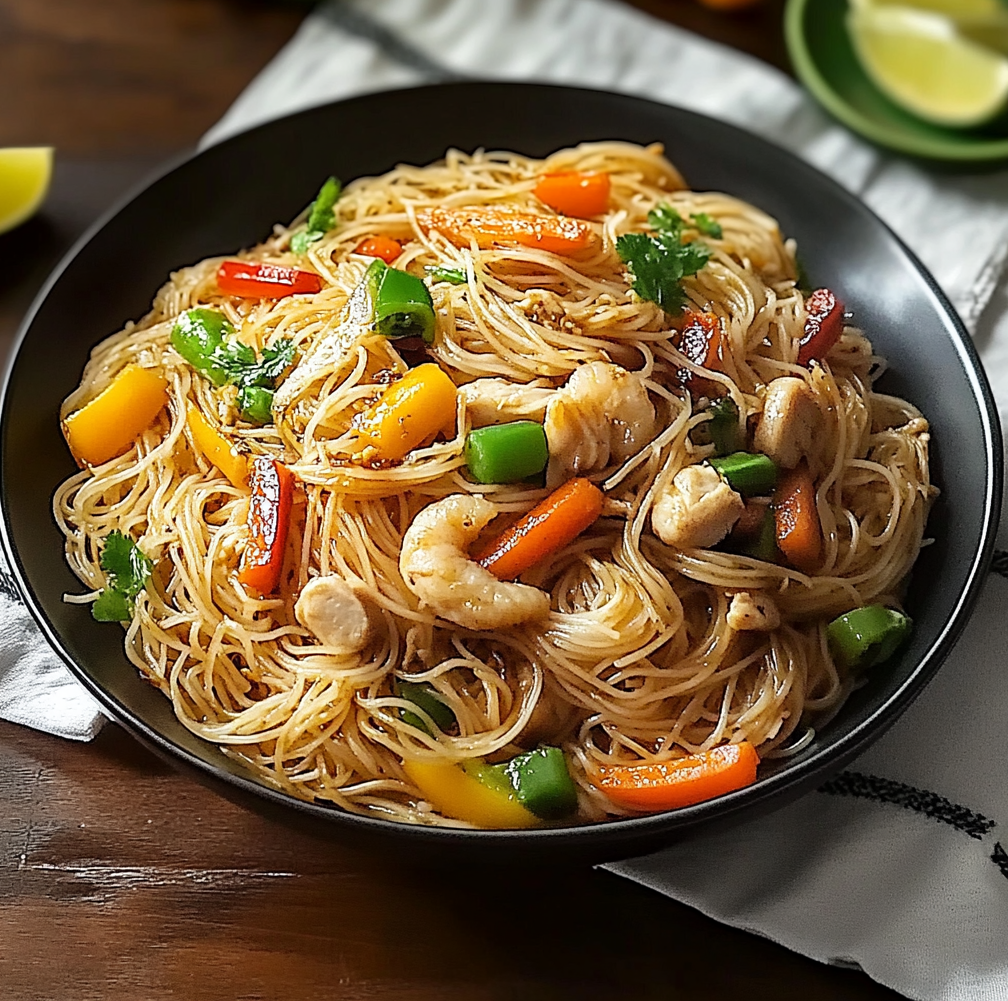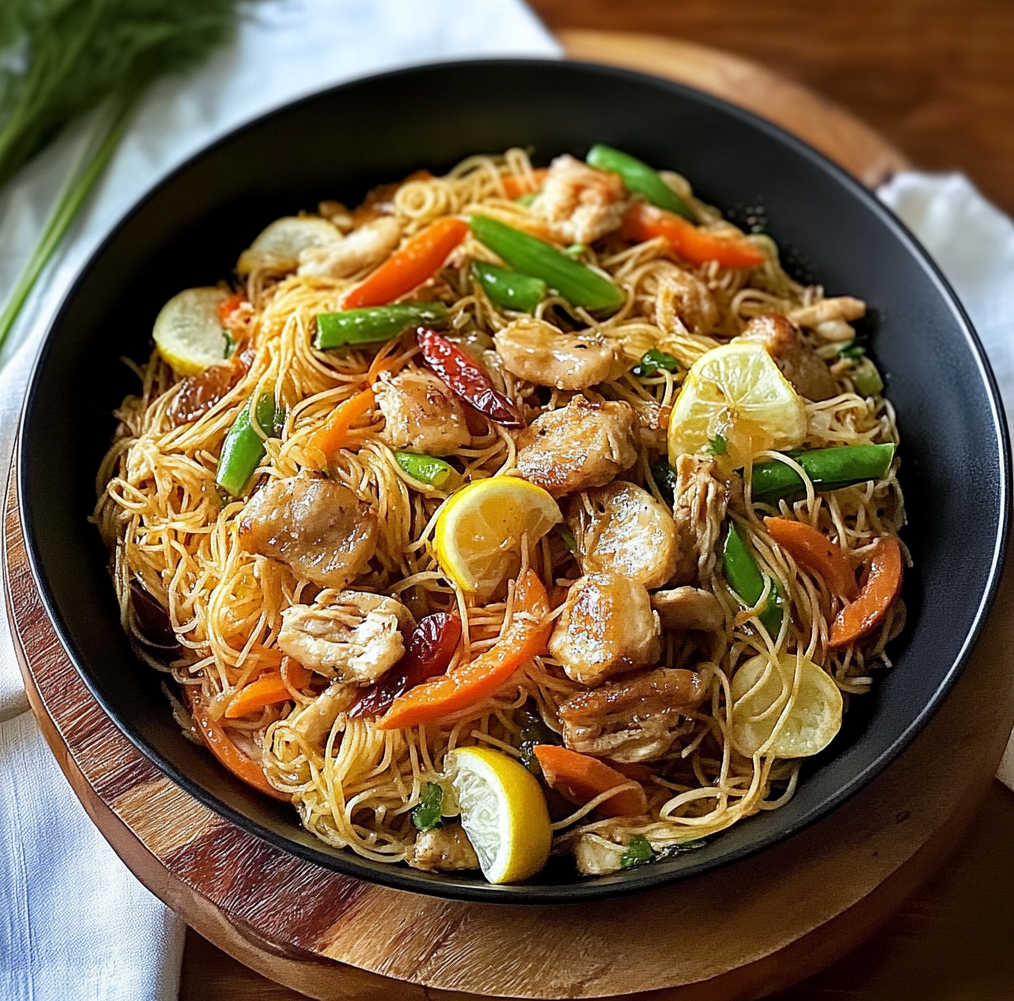Pancit, a beloved Filipino noodle dish, brings together tender chicken, crisp vegetables, and rice noodles in a rich, savory sauce. The blend of soy sauce and oyster sauce lends a depth of flavor that complements the freshness of the vegetables, creating a delightful balance in each bite.
This recipe is perfect for a busy weeknight or a weekend gathering. Pancit is versatile and easy to prepare, allowing you to adjust the ingredients to your liking. Serve it with a squeeze of lemon for an added zing, and you’ve got a satisfying meal that transports you to the vibrant flavors of the Philippines. Ideal for family dinners, potlucks, or whenever you crave something warm and comforting, this dish is sure to please.
Full Recipe:
- 1 tablespoon vegetable oil
- 1 onion, sliced
- 2 cloves garlic, minced
- 1/2 pound boneless, skinless chicken thighs, cut into small strips
- 1/2 cup carrots, julienned
- 1/2 cup snow peas
- 1/2 cup cabbage, shredded
- 1/4 cup soy sauce
- 1 tablespoon oyster sauce
- 1/2 teaspoon ground black pepper
- 1/2 pound rice noodles
- 1 cup chicken broth
- Lemon wedges, for garnish
Directions:
- Heat vegetable oil in a large skillet or wok over medium-high heat.
- Add sliced onion and minced garlic, and sauté until fragrant.
- Add chicken strips to the skillet and cook until golden brown and cooked through.
- Add carrots, snow peas, and cabbage to the skillet. Stir-fry for about 2-3 minutes, or until the vegetables are tender but still crisp.
- In a small bowl, mix soy sauce, oyster sauce, and black pepper, then pour over the chicken and vegetables. Stir to coat everything evenly.
- Add the rice noodles and chicken broth to the skillet. Gently toss until the noodles absorb the broth and are heated through, about 3-5 minutes.
- Serve with lemon wedges on the side for an extra burst of flavor.
Prep Time: 15 minutes | Cooking Time: 15 minutes | Total Time: 30 minutes
Kcal: 280 kcal | Servings: 4 servings
Pancit: A Filipino Classic Bringing Flavor and Tradition to the Table
Pancit, a versatile and beloved noodle dish, is one of the cornerstone recipes of Filipino cuisine. Rooted in the rich history of the Philippines, Pancit is known for its unique blend of textures and flavors that balance savory and fresh ingredients harmoniously. While each region and even family may prepare it differently, Pancit remains a universally cherished dish that brings people together over its comforting and satisfying flavors.
As you delve into the world of Pancit, you’ll discover a meal steeped in cultural tradition, often featured at celebrations, family gatherings, and even daily meals. This noodle-based dish, often enhanced with fresh vegetables, tender meats, and flavorful seasonings, has made its way to tables worldwide, appealing to those who crave hearty and delightful flavors with a taste of Filipino culture.
Cultural Significance of Pancit in the Philippines
Pancit’s origins trace back to Chinese immigrants who introduced noodle dishes to the Philippines, where they were adapted and transformed into what Filipinos now recognize as traditional Filipino Pancit. Over the years, it became a symbol of longevity and good fortune, often served during birthdays and other significant celebrations. The word “Pancit” itself derives from the Hokkien Chinese word “pian i sit,” which means “convenient food.” Pancit is as much a celebration of life as it is a meal, and its importance is deeply woven into Filipino culture.
Every family and cook has their own take on Pancit, which makes it not just a recipe but a reflection of the cook’s personal taste and regional influences. In Filipino culture, Pancit is often prepared in large quantities to share with friends and family, symbolizing generosity and unity. Many types of Pancit exist across the Philippines, from Pancit Canton to Pancit Bihon, each with slight variations that make it unique to a specific region or family tradition.
A Flavor Profile That Balances Savory and Fresh
The beauty of Pancit lies in its harmonious blend of ingredients that create a unique flavor profile. At its core, Pancit features rice noodles or wheat noodles cooked with savory elements like soy sauce and oyster sauce, which provide depth and umami. The noodles are then enhanced with fresh vegetables, such as cabbage, carrots, and snow peas, adding crunch and a hint of sweetness that balances the savory base.
The addition of chicken or pork adds a tender, juicy element to the dish, while garlic and onion bring an aromatic richness that ties everything together. Lemon or calamansi (a small Filipino citrus fruit) is often added as a garnish to brighten the dish with a subtle acidity that cuts through the richness. Each bite of Pancit brings a satisfying medley of textures and flavors, from the soft noodles to the crisp vegetables and the savory, seasoned meat.
Health Benefits of Pancit
Pancit is a well-rounded dish that can be as nutritious as it is delicious. Its ingredients make it a balanced meal, offering a mix of carbohydrates, proteins, and fiber, which provide sustained energy and fullness. Here’s a closer look at some of its nutritional benefits:
- Rich in Fiber: Pancit’s vegetable components like cabbage, carrots, and snow peas are excellent sources of dietary fiber, which supports digestion and helps maintain a healthy weight.
- High in Protein: With the addition of chicken, pork, or shrimp, Pancit offers a good amount of protein that helps build and repair tissues, making it a substantial meal option.
- Low in Fat: While Pancit can be fried in a small amount of oil, it’s generally low in fat compared to other stir-fried dishes, especially if you use lean cuts of meat.
- Customizable for Dietary Needs: Pancit can easily be adapted to fit various dietary preferences. For those seeking a vegetarian option, meat can be replaced with tofu or tempeh. Alternatively, reducing the salt in the sauces or opting for gluten-free noodles makes Pancit suitable for low-sodium or gluten-free diets.
Variations of Pancit Across the Philippines
Filipino cuisine celebrates diversity, and Pancit is a prime example of how traditional recipes can vary across regions. Here are some popular types of Pancit you might encounter:
- Pancit Bihon: This is perhaps the most common version of Pancit, made with thin rice noodles stir-fried with soy sauce, vegetables, and meat. It’s light and flavorful, perfect for casual meals or parties.
- Pancit Canton: Similar to Chinese stir-fried noodles, Pancit Canton uses wheat noodles instead of rice noodles. The dish is heartier and offers a denser, chewy texture.
- Pancit Malabon: Known for its seafood base, Pancit Malabon uses thicker rice noodles and is often topped with shrimp, smoked fish, and hard-boiled eggs. It has a savory, seafood-rich flavor that sets it apart.
- Pancit Palabok: This vibrant dish is known for its orange sauce made from annatto seeds and shrimp paste. Topped with chicharron (pork cracklings), hard-boiled eggs, and green onions, Pancit Palabok is a feast for the eyes and the palate.
- Pancit Habhab: Native to the Quezon province, Pancit Habhab is served on banana leaves and eaten without utensils. It’s a unique cultural experience as well as a meal.
Each type of Pancit has its own distinct flavor and ingredients, showcasing the diversity and adaptability of Filipino cuisine.
Cooking Tips for a Perfect Pancit
Making Pancit may seem straightforward, but a few cooking tips can elevate your dish from good to outstanding:
- Prepare Ingredients in Advance: Pancit cooks quickly, so it’s best to have all ingredients prepped and ready before you start cooking. This way, you can move smoothly from one step to the next.
- Use Fresh Ingredients: The quality of the vegetables and meat can greatly impact the flavor of your Pancit. Fresh vegetables will add a delightful crunch and color to the dish.
- Don’t Overcook the Noodles: Noodles should be cooked until just tender. Overcooking can make them mushy and cause them to break apart.
- Season Gradually: Start with small amounts of soy and oyster sauce, then adjust to taste. It’s easy to add more seasoning if needed, but difficult to reduce once added.
- Garnish for Added Flavor: A squeeze of lemon or calamansi just before serving can brighten the flavors of Pancit, making it even more enjoyable.
Serving Suggestions and Pairings
Pancit is often enjoyed as a standalone meal, but it pairs well with several sides and beverages to make a complete Filipino feast. Here are a few ideas:
- Lumpia (Filipino Spring Rolls): Lumpia’s crispy texture and savory filling provide a delightful contrast to the soft, chewy Pancit noodles.
- Garlic Fried Rice: While Pancit is a noodle dish, serving it with garlic fried rice can create a heartier meal, especially when feeding a large group.
- Adobo: Another Filipino classic, adobo is a flavorful dish with tender meat marinated in vinegar, soy sauce, and spices. The combination of adobo and Pancit is a favorite pairing.
- Fruit Salad: A light and sweet fruit salad can be the perfect dessert after a savory Pancit meal, adding a refreshing balance to the table.
- Iced Tea or Calamansi Juice: These beverages are refreshing and complement Pancit’s rich flavors. Calamansi juice, with its slightly tart profile, is especially popular with Filipino meals.
Conclusion: Why Pancit is Worth Adding to Your Culinary Repertoire
Pancit is more than just a meal—it’s an experience that brings a taste of Filipino culture to your kitchen. Whether you’re looking for a comforting dish for a family meal, a flavorful option for entertaining guests, or a unique recipe to expand your culinary horizons, Pancit is a fantastic choice. Its balanced flavor profile, nutritional benefits, and adaptability make it a versatile dish suitable for various dietary preferences and occasions.
By adding Pancit to your menu, you not only learn about Filipino cuisine but also participate in a culinary tradition that values community, generosity, and flavor. As you share this dish with others, you become part of a larger story that celebrates the joy of food and the beauty of cultural heritage. So, next time you’re craving something warm, savory, and soul-satisfying, give Pancit a try—you might just find a new favorite to enjoy and share.
Print
Savory Filipino Pancit Noodles with Vegetables and Chicken
- Total Time: 30 minutes
Description
Pancit, a beloved Filipino noodle dish, brings together tender chicken, crisp vegetables, and rice noodles in a rich, savory sauce. The blend of soy sauce and oyster sauce lends a depth of flavor that complements the freshness of the vegetables, creating a delightful balance in each bite.
This recipe is perfect for a busy weeknight or a weekend gathering. Pancit is versatile and easy to prepare, allowing you to adjust the ingredients to your liking. Serve it with a squeeze of lemon for an added zing, and you’ve got a satisfying meal that transports you to the vibrant flavors of the Philippines. Ideal for family dinners, potlucks, or whenever you crave something warm and comforting, this dish is sure to please.
Ingredients
- 1 tablespoon vegetable oil
- 1 onion, sliced
- 2 cloves garlic, minced
- 1/2 pound boneless, skinless chicken thighs, cut into small strips
- 1/2 cup carrots, julienned
- 1/2 cup snow peas
- 1/2 cup cabbage, shredded
- 1/4 cup soy sauce
- 1 tablespoon oyster sauce
- 1/2 teaspoon ground black pepper
- 1/2 pound rice noodles
- 1 cup chicken broth
- Lemon wedges, for garnish
Instructions
- Heat vegetable oil in a large skillet or wok over medium-high heat.
- Add sliced onion and minced garlic, and sauté until fragrant.
- Add chicken strips to the skillet and cook until golden brown and cooked through.
- Add carrots, snow peas, and cabbage to the skillet. Stir-fry for about 2-3 minutes, or until the vegetables are tender but still crisp.
- In a small bowl, mix soy sauce, oyster sauce, and black pepper, then pour over the chicken and vegetables. Stir to coat everything evenly.
- Add the rice noodles and chicken broth to the skillet. Gently toss until the noodles absorb the broth and are heated through, about 3-5 minutes.
- Serve with lemon wedges on the side for an extra burst of flavor.
- Prep Time: 15 minutes
- Cook Time: 15 minutes








